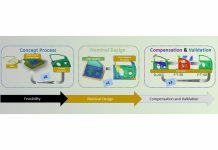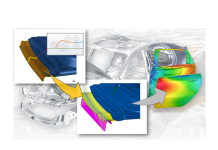In today’s technologically fast-paced manufacturing realm, companies can operate smoothly and efficiently if they have the proper software tools to aid them in achieving their process chain steps. By the same measure, their performance and workflow can become bottlenecked without the software tools to perform the required task and/or if they have to out-source the work. Some software packages only assist in certain process steps and are not compatible with other software packages. So, maybe it’s time to evaluate your current software. What are the advantages or disadvantages? Do they facilitate task completion and a smooth transition from product design to part production and even assembly when required? Is the software efficient, accurate, and easy to use?
Industry-leading software solutions can assist companies in their sheet metal forming, tryout, and assembly processes only if the software has been continually developed to keep up with or even drive today’s technology. If that’s the case, then they can promote a seamless processing chain in nearly all of its stages (please refer to Innovations (autoform.com) for more information). This begins at the early stage of product development, assisting engineers with early feasibility analysis, and incorporates every stage until part production (see images below).
(Click to enlarge)
With a proactive approach to the manufacturing process chain and the software to support each stage, companies can establish a continuous forward processing technique. What does this mean? Let’s imagine an issue arising with the material thinning, splitting, or even encountering springback during the manufacturing process; does manufacturing then have to consult engineering to resolve the issues? What if there were software tools to support the engineering process and provide the necessary information to the shop floor? It would be a huge asset if manufacturing didn’t have to go back to engineering for help with their problem solving! What if you could evaluate and predict issues with the assembly of certain parts before they were assembled at the plant? With software modules to support tryout and assembly, companies can achieve a seamless process chain.
AutoForm’s tryout software allows manufacturing to review the change history in the engineering simulation process and even make certain adjustments to resolve issues that arise during the manufacturing process. In the assembly of certain parts, the springback can differ from the single part stage and then change again during the assembly process. Can this be predicted and/or altered with simulation assembly software? Yes, by offering software modules for tryout and assembly, AutoForm helps companies take a more proactive approach to resolving issues that may occur in their process chain. Essentially, this comes down to a healthier and more efficient company process chain by facilitating digital information sharing and communication between the departments within their process chain.
The below images illustrate the recently added software support modules of tribology, tryout, and BiW assemblies.
(Click to enlarge)
Whether your company is a smaller manufacturing tool shop or a larger OEM, your software should have the capacity to accommodate your current requirements and fulfill future growth when needed. With the software technology available today, companies have no reason for bottlenecking or continually running into roadblocks. And software companies should be helping their customers save time, material, and money without requiring a PhD to operate their software.
For information on AutoForm’s software modules and capabilities, please visit:
Software Solutions for Sheet Metal Forming | AutoForm Engineering
Matt Kruithoff
Sr. Application Engineer
AutoForm, USA















